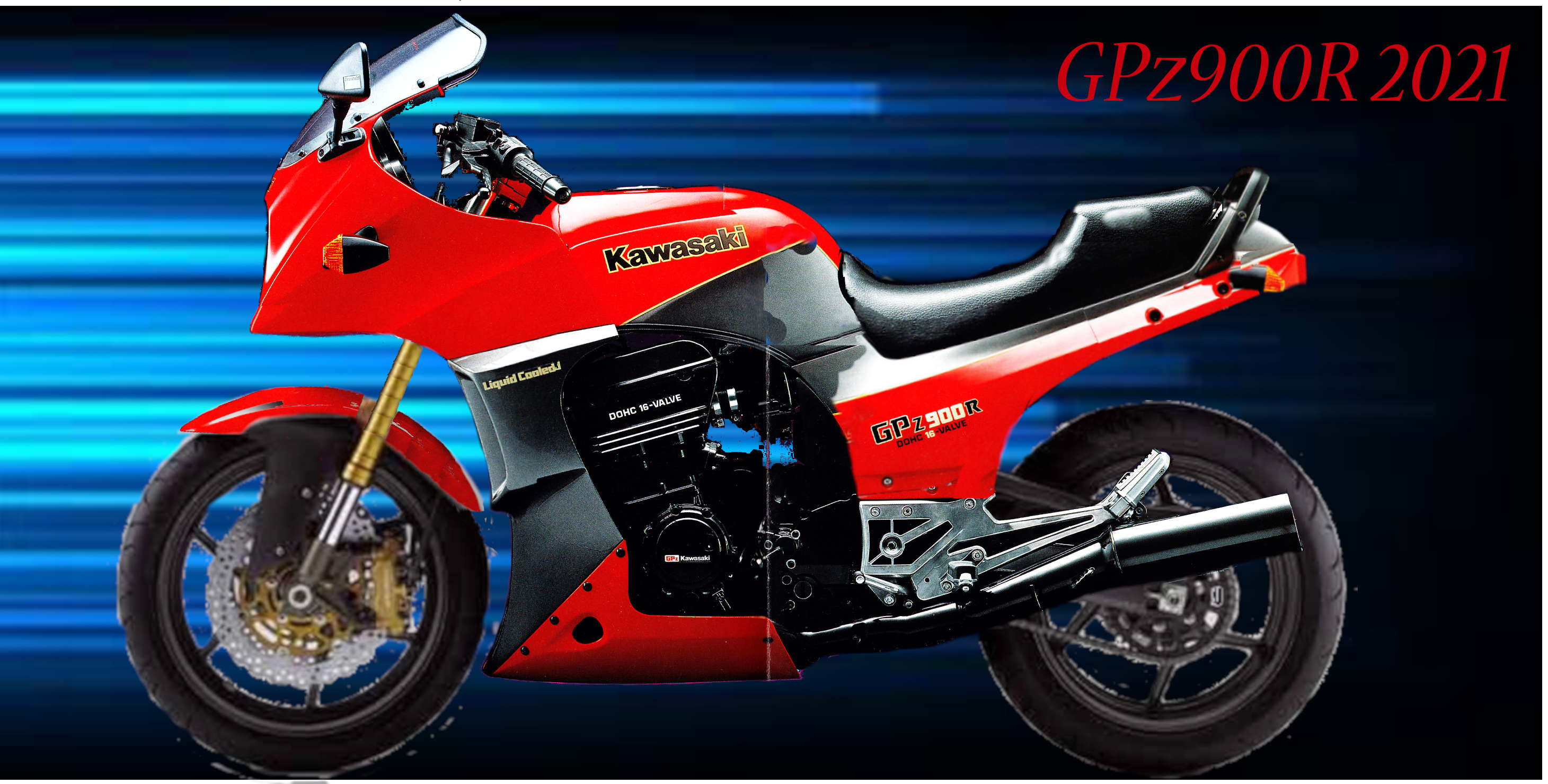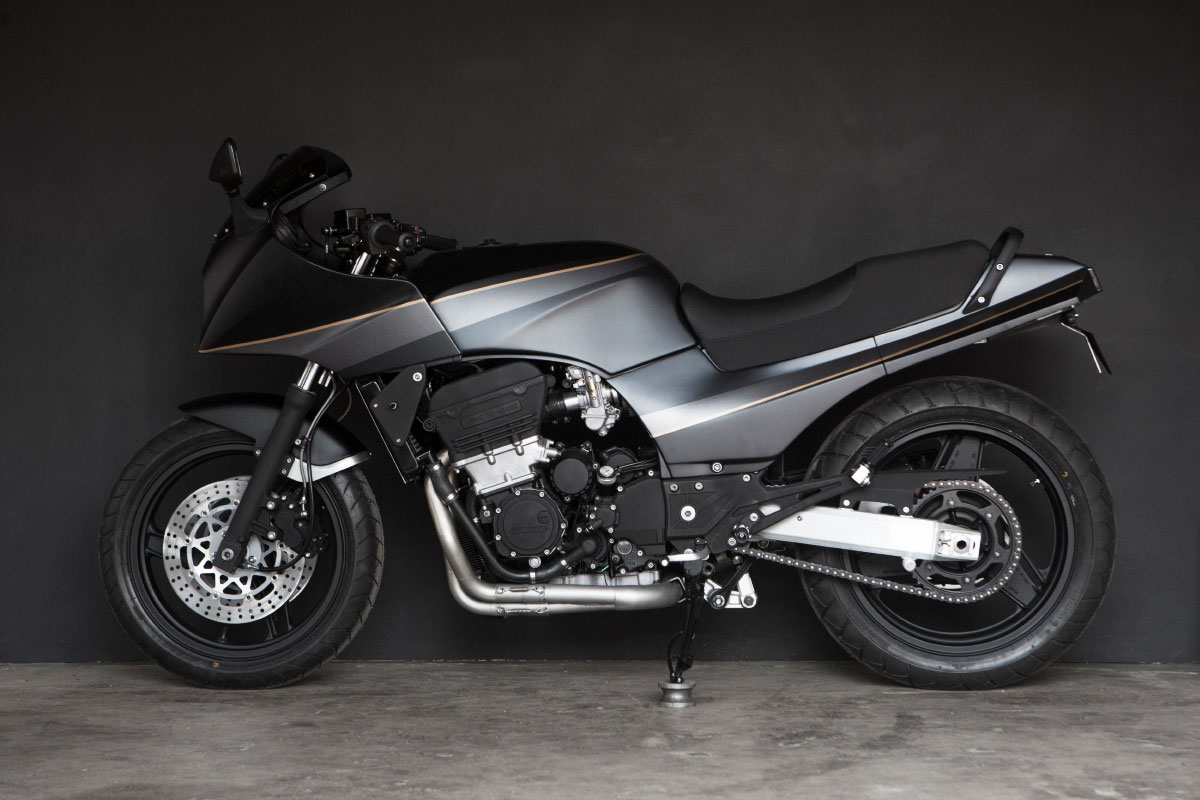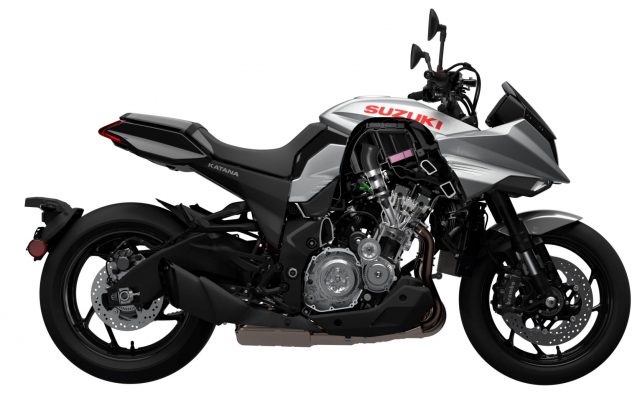Resources
A Retro GPz900R

 |
 |
| WrenchMonkees | mcnews.com.au |
For 2034 I would love Kawasaki to release a 50th anniversary Ninja.
Feb 2021 update: I have based the design above on the existing engine/gearbox but it seems clear that in 2034 bikes will be electric!
But to be brutally honest I’m not sure how a factory retro would work. The difficulty with corporate retro designs is that they clearly must be developed as a commercial opportunity, however they are also often competing directly with other models. So would Kawasaki target new or current owners? As this car article points out: “A retro design gone wrong is an abomination. “
With cars you can sometimes bypass the most complicated design criteria, visuals, by keeping the exterior virtually identical to the original. This is far more difficult with classic motorcycles because the core technology simply isn’t always hidden and so much has changed. As Suzuki Chief Engineer Saturo Terada points out in 2020: “the new Katana is not a ‘retro’ bike.”
Modernise
Many current owners modernise their bikes and do so with great talent and imagination. I personally like the WrenchMonkees update, but whilst I appreciate the cafe-racer style I feel a true retro bike needs to be fully dressed with a full fairing.
One of the questions I always ponder about modernising is: why?
Yes, later and bigger engines give more power, different rims give wider tyres, better brakes, forks and swing-arms all improve the bike – but not really by much. An original GPz900R is *still* an excellent handling road bike, but a modernised GPz900R is still dynamically far behind a modern bike.
Geometry
A core reason is the geometry of the early 1980’s superbikes, because they are significantly longer with slower steering (rake & trail) than modern bikes. The wheelbase and rake angle of a 1982 Katana is 1520mm & 30°, the 2020 Katana is 1460mm & 25°. Which is an awful lot for motorcycles, where rake angles of 0.2° and rear ride height changes of 2mm are often considered significant!
This is an observation not a criticism – at the time these were cutting-edge numbers and these were fastest things on two wheels. The ‘slower turning’ geometry gives good stability at high-speed, obviously a useful trait on a +150mph motorcycle, and as argued in Superbikes it was the relatively safety of the GPz900R that was likely more influential on the industry than it’s pure top speed.
But with modern technology (eg. steering dampers) superbikes can now have sharper turning geometry, and front forks have improved so much that the modern rider position is now significantly further forward. If you ride a GPz hard you know it doesn’t have the ‘softest’ suspension! Perhaps it is the rider position that now explains the short tail & big tank modern design. The same geometry dilemma applies to a retro GPz and modifying to a modern layout (1000SX) requires significant structural changes.
- Changing the rake angle from 29 to 24 means a major frame modification.
- Moving the rider forward means tank & frame changes as well as intake mods – although FI would hopefully save some space. One of the few mods I have to my A8 is a deep-dish seat, this makes such a huge improvement to spirited riding I simply had to replace the original design.
- Rake change helps, but changes to the swing-arm length or pivot pint might also be required to shorten wheelbase from 1490 to 1430. I have used a 2005 ZX-6 swing arm because it is still visually similar to the original. Modern bikes use a much bigger swing-arm but it just didn’t look right.
Visuals
The GPz is an iconic design, and, IMHO, one of the absolute best to ever come out of Japan. Visually striking and what I adore is the lightness of the design – from almost all angles. Except the rear mudguard and plate light! Uuurgh. Modern bikes are visually ‘heavy’, with almost no space between the fairing and the front wheel and didn’t help with creating the ‘plastic fantastic’ image. The GPz fairings are a perfect example of the ‘form-follows-function’ design mantra and still being able to see directly through the engine – awesome.
But that does pose a challenge to making the design visually modern. The retro bike needs to keep the ‘lightness’ of the design, and for me the engine silhouette and rearset aluminium castings are core GPz900R visuals that I wanted to keep.
I also wanted to keep a proper pillion seat & grab rail – to me this is also part of the original design & era. And still useful!
Twin Exhaust
Although most modern sportsbikes use a 4-1 or 4-2-1 system generally folks dislike the mufflers, a tricky one for manufacturers because of tighter emissions. So the original twin system allows for plenty of room and scope for emissions options and actually still looks perfect.
Summary
Some initial forum reactions to the Feb 2021 design were sarcastic, suggesting all I did was remove the rear fender and use a different seat! Ironically this is perhaps the best confirmation of the new design, because these members haven’t noticed that the *only* parts unchanged were the engine, belly fairing, rearsets & exhaust!
With retro design success is by what you don’t see!
As explained above the shorter rear tail is mainly due to the whole sub-assembly moving forward, moving the rider forward and, at the same time, moving the pegs back – something I would prefer on my A8!
But early feedback is that many owners still prefer the original tail, and this leads to what I feel is the core design criteria for this retro bike:
Designed by Owners for Owners.
Today we realise the bike could have been edgier, and especially with today’s material and technological advancements there is no reason the design and vision of the original Kawasaki engineers can’t be updated into a spectacular modern motorcycle.
But it won’t be a normal production bike development. There’s too much at stake for that – too much customer research, too much investment, too much risk. Instead I’m asking Kawasaki to acknowledge one of the companies greatest motorcycles by producing a limited run of working prototype bikes that recognise, applaud and honor the 50th birthday of the Ninja.
How many? Probably only a handful.
1. Modernise, but…..
We can keep the iconic core spine frame and engine, but let’s improve the front & rear ends and tweak the geometry to give us sharper, more edgy machine that’s more like modern machinery and again represents the Ninja name.
Let’s reduce weight where we can (eg. rims), better brakes and add techno like ABS, quick shifters, steering dampers & fuel injection.
Umm, and maybe a better static cooling system…..
But I don’t think owners want electronic controlled throttles, 6-way gyroscopes, moon launch buttons or other James Bond stuff; we still want to ride the bike ourselves. But maybe electronic front dampening is fair enough, after all the original AVS shows that this was always seen by Kawasaki engineers as a key area for development.
An important reality is that these will NOT be bikes built to comply with road regulations like Australian Design Rules (ADR).
Again this is simply to keep this project within reason for Kawasaki, and it also means that these rules & regulations (eg emissions) will not impede on the final design. For this reason it can use components of other motorcycles as long as their design still fits within the Ninja template.
2. The Look
The common theme for all updates on a GPz900r is that the bike is still always recognisable as a Ninja.
So it’s simple, the 2034 bike needs very similar styling. For me this includes little visual clues like being still able to see through the bike (under the carbs), because these are features that basically disappeared with all of the Japanese sportsbikes that followed.
To keep the iconic side profile I think we have no choice but to keep the same engine, but of course let’s improve where we can. Maybe it really does become the successor the GPz1000r should have been (ie use the RX1000 engine) OR do we keep it as a 900? OR use the 972/973 big bore kits? No matter what IMHO the goal should be for better low & midrange performance.
Why not top end? Well, I actually think the 2034 bike should be geared for just 160mph.
Feb 2021 Update: the 2021 design does use the same engine but I honestly think in 2034 bikes will be electric!
This isn’t going to be a H2, nor is it reasonable to ask Kawasaki to engineer the 2034 bike for the sort of speeds modern superbikes travel at. Capping the speed at just over 150mph gives the engineers much more scope to ensure they deliver a beautiful & complete handling package – one of the significant achievements of the original bike. Breaking the 150mph barrier was another one of the GPz900r’s milestone achievements and let’s get real; no-one needs to be riding that fast on the road. 160mph simply means the bike should top 150mph under almost any conditions.
With less weight, more torque & ponies gearing the bike for 160mph should improve her acceleration even further, again a performance measure that was outstanding with the original bike.
3. The Owners
The GPZ900r was a fine machine, however the longevity of the bike was purely due to her owners.
As the top performance motorcycle she was soon de-throned, yet buyers simply would not let Kawasaki end production. And since the last Ninja rolled off the production line (I wonder where that one is?) owners all over the world have continued to maintain, restore, modify and keep alive these wonderful machines.
So this 2034 bike should be ours.
And we could potentailly do that by being a core part of the design process. Yes, we decide what we would like. And this will be a long-term project that invites every single GPz900r owner from across the globe to participate giving Kawasaki the design criteria to build some 2034 demonstraion bikes.
How amazing would that be!
Marketing & Promotion
How many bikes will be built? I’m hoping for at least 9. Remember these won’t be bikes developed for the road. At the end of the day there are simply endless possibilities for Kawasaki promotion simply by honouring the incredible legacy of the GPz900r, and reminding folks from right now to 2034 of just how important this machine was to motorcycling history.
During Development
As soon as Kawasaki engage in this project there would great marketing opportunities for years & years.
Any motorcycling journalist, especially social media platforms, will be involved in this process from Day One. One of the key success factors of social media channels is individuals get a say, they are engaged. This process of having GPz900R owners be the design client is simply an extension of that concept.
And even though the talk will be about the 2034 GPz900r – that still means Ninja and it still means Kawasaki.
Public Launch
After this comprehensive build-up there needs to be a spectacular Invite-Only reveal. Who knows if international motorcycle shows will even still exist in 2034, but maybe something like that?
Journalists, online reviewers, celebrities (Mr Cruise if still kicking?) and a spectacular environment are all there to parade the bike in it’s full glory and provide lots of marketing and advertising material for Kawasaki.
And it doesn’t even need to be a Naval Air force base, that is a bit corny!
Promotional Tour
I’m hoping owners will also get the opportunity to ride the bike. Even if there was only just one location in every country (so in Australia that would obviously mean Adelaide!) where the bike was sold, at least everyone gets the chance.
Imagine that there were ride days where owners could come to Kawasaki dealership events where they can ride an original machine (an A1-A6), a later version (A7+) and then of course the 2034 bike. And of course they have the opportunity to ride any modern machinery as well.
You know I could almost hang up my boots after that.
Hopefully they ride their GPz900R there as well for even more fantastic photo opportunities and face-to-face contact for dealers with potential customers.
These ride days might even be open to the general public, but owners get priority!
You Name It
Of course the bikes could then be sent to motorcycle shows, race events, travel around to dealerships for rolling display, etc. etc. All of this simply continues to attract public interest in Kawasaki to see the bike that started the incredible Ninja brand.
Maybe some bikes go to auction, maybe some bikes are offered as a competition prize (to folks who buy a new 2034 bike), hopefully one bike will be randomly awarded to one of the owners who helped develop it.
GPz900R (ZX900) Database
Number of owner contacted & confirmed bikes.
A1
A2
A3
A4
A5
A5A
A6
A7
A8
A9
A10
A11
A12
A13
A14
A15
A16
Top Gun
About the Site
My family loves older vehicles, the newest one we own is 2003! But I am acutely aware of the ownership complexities especially:
- they often need more 'hands-on' mechanical work &;
- there often isn't any local expertise from the service centres;
- there is often no new parts available from the manufacturer;
- parts often have to be sourced 2nd-hand or from overseas.
So we often end up doing a lot of the research & work ourselves and this information gets stored either locally with the bike or online forums - although finding the useful parts in these forums isn't always simple.
The original goal of the site was simply somewhere for me to record service work & contacts on my GPz900r so that my kids (the one that likes bikes anyway!) could easily access it - it doesn't concern me if it was publicly available.
I then realised that with this online structure in place I could also offer it to other owners, and the site could potentially expand to record other owners experiences and expertise , meaning we can learn from others but also pass on this knowledge to subsequent owners of these wonderful motorcycles.
At least Covid-19 has given me plenty of spare time to pursue my passion for the motorcycle!

Location
Adelaide
South Australia
gpz900r@motoshoot.com.au
Timeline
1983 - Honda XR200
1984 - wanted a GPz
1985-2013 - cars+family
2014 - finally got one!
Disclaimer
The information provided on this site (or links) is personal experiences from non-professional home-mechanics, so neither it's accuracy nor it's validity can be confirmed. If you need professional advise please visit your local Kawasaki dealership or a qualified industry professional.
Like riding any motorcycle, at the end of the day the only opinion that really counts is your own!